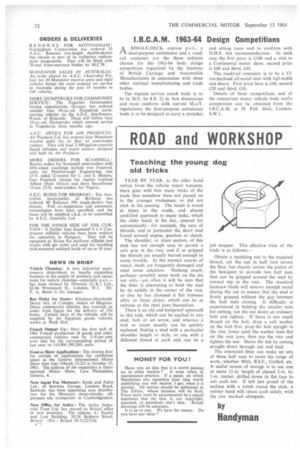ROAD and WORKSHOP
Page 54

If you've noticed an error in this article please click here to report it so we can fix it.
Teaching the young dog old tricks
YEAR BY YEAR, as the older hand retires from the vehicle repair business, there goes with him many tricks of the trade that somehow were not passed on to the younger tradesmen, or did not stick in the passing. The result is noted at times in the crude, and almost unskilled approach to many tasks, which the older hand, in his day, catered for automatically—for example, the care of threads, and in particular the short stud found around engine, gearbox or clutch.
The shoulder, or plain section, of this stud has not enough area to permit a safe grip in the vice, and if so gripped the threads are usually burred enough to cause trouble. In the normal course of repair, studs are frequently damaged and need some attention. Nothing much, perhaps—possibly some work on the die nut only—yet often it will be seen that the fitter is attempting to hold the stud by its middle in the corner of the vice, or else he has clamped it flat between alloy or brass plates, which can be as ruinous as the steel jaws themselves.
There is an old and foolproof approach to this task, which can be applied to any stud, bolt or set screw, and whereas a bolt or screw usually can be quickly replaced, finding a stud with a particular shoulder length or style, or one with a different thread at each end, can be a job stopper. This effective trick of the trade is as follows:— Obtain a matching nut to the required thread, cut the nut in half (not across the flats, but cleanly across the points of the hexagon) to provide two half nuts that can be gripped around the stud by normal nip in the vice. The standard hacksaw blade will remove enough metal during the cut to ensure that the stud is firmly gripped without the gap between the half nuts closing. If difficulty is experienced in holding the smaller nuts for cutting, run the nut down an ordinary bolt and tighten. If there is too much thread on the bolt, drop a soft washer on the bolt first, prop the bolt upright in the vice, lower until the washer rests flat on the vice jaws, then nip the vice and tighten the nut. Halve the nut by cutting straight down through nut and stud.
The interested fitter can make up sets of these half nuts to cover his range of work, whether Whit, B.S.F., Unified, etc. A useful means of storage is to use one or more 12-in, length of planed 2-in. by 1-in, timber, drilled down its flat face to suit each nut. If left just proud of the surface with a notch round the stick, a rubber band will retain each safely, with the size marked alongside.
by
Handyman




















































































































